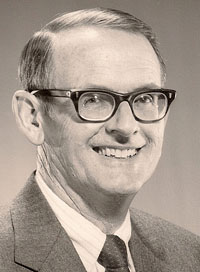Obituary
Frederick Sherman
03 December 2008
 BERKELEY — Frederick Sherman, professor emer-itus of mechanical engineering and an expert on the dynamics of high-speed airflow in the upper atmosphere, has died at the age of 80.
BERKELEY — Frederick Sherman, professor emer-itus of mechanical engineering and an expert on the dynamics of high-speed airflow in the upper atmosphere, has died at the age of 80.
Sherman died Oct. 27 of respiratory failure at the Alta Bates Medical Center in Berkeley after a battle with prostate cancer.
He joined the Berkeley faculty in 1954, working with colleagues to conduct pioneering research on the behavior of rarefied gases encountered at very high altitudes. The Berkeley team of aeronautical and space scientists, led by engineering professor Samuel Schaaf, used low-density wind tunnels to replicate the conditions satellites and spacecraft encountered in the upper atmosphere.
"The work Sherman and colleagues did in the 1950s and 1960s played a monumental role in the early years of the U.S. space program," said Sherman's Berkeley colleague Stanley Berger, professor of mechanical engineering. "Understanding aerodynamic forces in an environment where there are fewer air molecules was and is critical for optimizing the function of satellites in orbit. No one would venture to launch a $200 million hardware into orbit without knowing how it will behave while there. At the time, Berkeley was one of the leading institutions in the world looking at this problem."
Berger noted that such questions have largely been resolved, and have made possible today's GPS devices, TV stations, and other technologies that rely upon satellites.
Sherman's work also influenced the era of supersonic flight, said Omer Savas, a Berkeley professor of mechanical engineering. "He conducted seminal work on the structure of shockwaves when gases go from supersonic to subsonic conditions, which causes the phenomenon known as the sonic boom," said Savas. "Understanding shockwave structure is essential in designing aerodynamic shapes for supersonic flight. It's information that is taken for granted now."
Sherman was born in April 1928 in San Diego, where he grew up. After high school he headed east to Harvard College, where he graduated cum laude with a bachelor's degree in engineering science and applied physics. While at Harvard he was elected a member of Phi Beta Kappa and was a member of the crew team.
Sherman continued his education back in California, earning his M.S. and Ph.D. in mechanical engineering at Berkeley in 1950 and 1954, respectively. Upon graduating he became an instructor here, though his academic position was interrupted in 1956 by a two-year stint as the supervisor of the Aeromechanics Research Program in the Office of Naval Research in Washington, D.C.
In 1958 he returned to Berkeley as an assistant professor in the Department of Mechanical Engineering. He was promoted to associate professor a year later and to professor in 1965.
Fluid dynamics and the study of viscous flow were major topics of research for Sherman, who published a senior-graduate text, Viscous Flow, shortly before he retired from Berkeley in 1991.
He received a number of honors in his life, including a Distinguished Teaching Award from Berkeley in 1961.
After retirement from Berkeley, Sherman devoted more of his time to folk dancing and family genealogy. He served as president of the California Genealogical Society from 1994 to 1996, and was a member of the Society of Mayflower Descendants
Sherman is survived by his wife of more than 50 years, Patricia Sherman; two sons, John and Brad Sherman; and two grandchildren.
Donations in Sherman's memory can be sent to either the Landmark Heritage Foundation at the Berkeley City Club, 2315 Durant Ave. #306, Berkeley, CA 94704, or the First Congregational Church of Berkeley, 2345 Channing Way, Berkeley, CA 94704.
A memorial in Sherman's honor has been scheduled for late December at the Berkeley City Club. For more information, contact Debra Chin in the Department of Mechanical Engineering (chin@me.berkeley.edu).
— Sarah Yang

